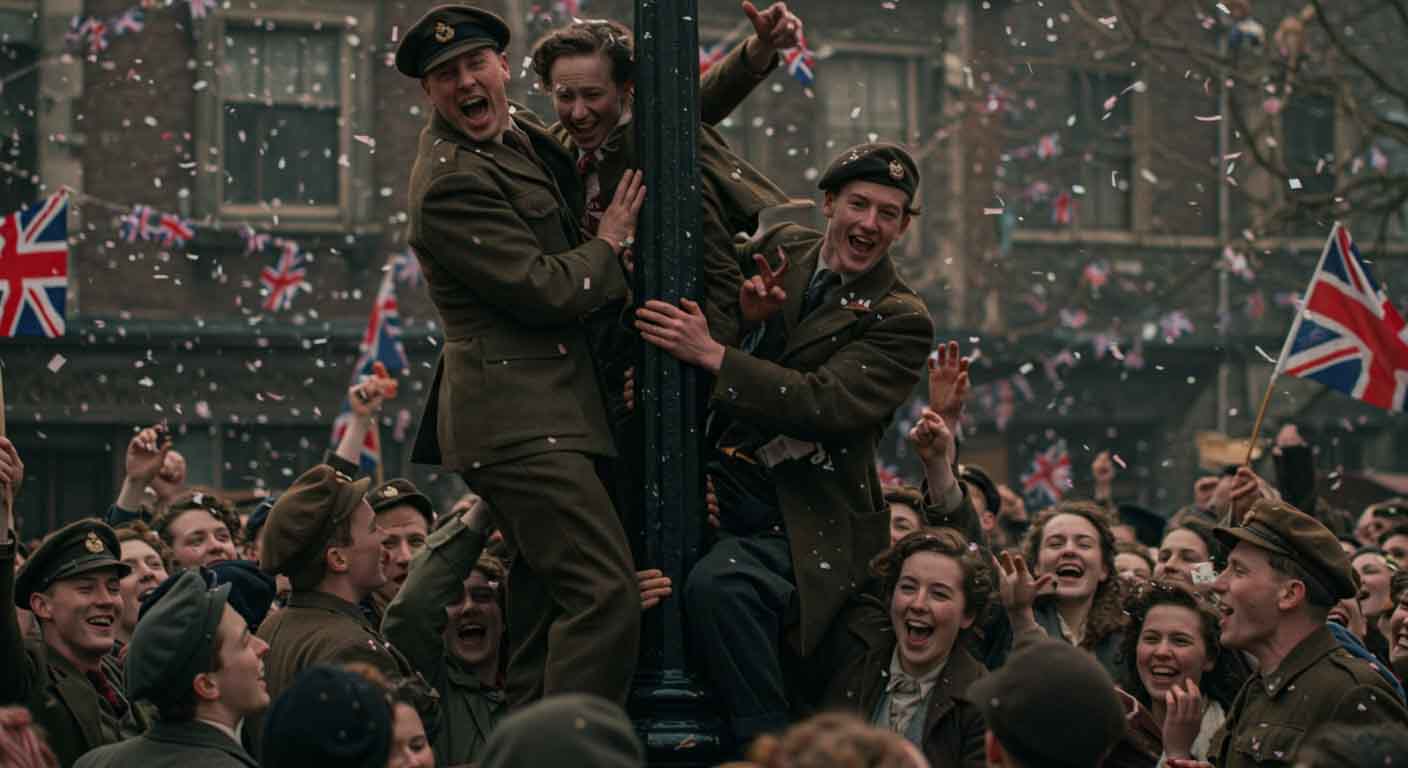The World in Celebration: When Peace Finally Dawned After Years of War
The Second World War, a conflict that had consumed the globe for six long, brutal years, was a period of unprecedented upheaval, sacrifice, and anxiety. Millions of lives were lost, nations were shattered, and the very fabric of society was torn. The shadow of war had stretched across continents, touching nearly every family, every community. So, when the news finally broke, not once but twice, that the fighting was over, the world erupted. Victory in Europe (VE Day) and, a few months later, Victory over Japan (VJ Day) were not just dates on a calendar; they were profound, cathartic moments of collective relief, unbridled joy, and solemn remembrance. These were the days the world had longed for, prayed for, and fought for.
The journey to VE Day in the spring of 1945 was one of grinding, relentless advance by the Allied forces. After the successful D-Day landings in June 1944, the push through Western Europe had been hard-fought. Simultaneously, on the Eastern Front, Soviet forces were driving relentlessly towards Berlin. As 1945 dawned, the noose around Nazi Germany was tightening. News from the front lines, though often censored and managed, began to carry a discernible note of optimism. People sensed that the end, in Europe at least, was near. The relentless bombing raids on German cities, the crossing of the Rhine in March, and the linking up of American and Soviet troops on the Elbe River in late April were all milestones that signalled the imminent collapse of the Third Reich. The suicide of Adolf Hitler on April 30th in his Berlin bunker removed the fanatical figurehead of the Nazi regime, and the German military machine, battered and broken, began to crumble. Anticipation hung heavy in the air, a mixture of hope and trepidation. Years of hardship, rationing, blackouts, and the constant fear of telegrams bearing tragic news had taken their toll. The prospect of peace was almost too much to dare to believe.
Then, it happened. On May 7th, 1945, at General Eisenhower’s headquarters in Reims, France, German General Alfred Jodl signed the unconditional surrender of all German forces. The news, though known to officials, was embargoed for a coordinated announcement. In Britain, the government declared that May 8th would be a national holiday – Victory in Europe Day. Prime Minister Winston Churchill, the bulldog spirit incarnate who had guided Britain through its darkest hours, was scheduled to address the nation at 3 p.m.
As that hour approached, streets across Britain, and indeed across the Allied world, began to fill. In London, vast throngs, estimated at over a million people, converged on Trafalgar Square, Piccadilly Circus, Whitehall, and outside Buckingham Palace. The atmosphere was electric. When Churchill’s voice finally boomed from radios across the land, confirming the news, a wave of euphoria swept through the crowds. “The German war is therefore at an end,” he declared, his words igniting a joyous pandemonium that had been suppressed for far too long.
The celebrations that followed were extraordinary in their spontaneity and scale. Years of blackout restrictions were gleefully cast aside. Lights blazed from windows, and bonfires, some topped with effigies of Hitler, roared into the night sky. Streets were strung with bunting – often homemade from scraps of material – and Union Jacks and Allied flags appeared everywhere. People danced in the streets: congas snaked through city centres, strangers embraced, and impromptu parties erupted on every corner. Pubs, their stocks often depleted, did a roaring trade, with singalongs spilling out onto the pavements. The sound of laughter, music, and cheering filled the air, a stark contrast to the wail of air raid sirens that had been the soundtrack of the preceding years.
King George VI and Queen Elizabeth, along with the young Princesses Elizabeth and Margaret, made several appearances on the balcony of Buckingham Palace to cheering multitudes. In a moment that has become legendary, the two princesses were even allowed to slip out of the palace incognito to join the revellers in the streets, experiencing the joyous chaos firsthand. Churchill, too, was greeted as a hero, appearing on the balcony of the Ministry of Health building in Whitehall, famously growling, “This is your victory!” to the adoring crowd. Services of thanksgiving were held in churches and cathedrals, packed with people offering prayers of gratitude for deliverance and remembrance for the fallen.
Similar scenes unfolded across the Allied nations. In Paris, which had been liberated the previous August, jubilant crowds thronged the Champs-Élysées. In New York, ticker-tape parades filled the streets. Yet, even amidst the elation, there was an undercurrent of solemnity. The cost of victory had been immense. Nearly every family had been touched by loss. For many, the joy was tinged with a profound sadness for those who would not return, for the years lost, and for the innocence shattered. Moreover, the war was not entirely over. The fight against Japan in the Far East continued, a grim reality that tempered the celebrations for those with loved ones still in harm’s way. Churchill himself, in his VE Day broadcast, reminded the nation: “We may allow ourselves a brief period of rejoicing; but let us not forget for a moment the toil and efforts that lie ahead. Japan, with all her treachery and greed, remains unsubdued.”
And so, while Europe began the slow, arduous task of rebuilding and healing, the war machine ground on in the Pacific. The fighting there had been characterized by its own particular brand of ferocity and brutality, across vast distances of ocean and jungle. Island by island, Allied forces, predominantly American, Australian, and British, had been pushing back the Japanese Empire. The battles of Iwo Jima and Okinawa in early 1945 were particularly bloody, demonstrating the Japanese military’s fanatical determination to fight to the last man. The prospect of an invasion of the Japanese home islands loomed, an operation that military planners predicted would result in catastrophic casualties on both sides.
It was against this backdrop that the world was irrevocably changed by the advent of a new, terrifying weapon. On August 6th, 1945, an American B-29 bomber, the Enola Gay, dropped an atomic bomb on the Japanese city of Hiroshima. Three days later, on August 9th, a second atomic bomb was dropped on Nagasaki. The devastation was unprecedented, the loss of civilian life horrifying. The use of these weapons remains a subject of intense historical and ethical debate, but in the context of August 1945, their impact was decisive. Faced with this unimaginable destructive power and the Soviet Union’s declaration of war on August 8th, followed by their invasion of Manchuria, the Japanese government, after intense internal debate, finally moved towards surrender.
On August 10th, premature reports of Japan’s surrender led to some early, albeit short-lived, celebrations in Allied countries. The formal, official announcement that Japan had accepted the Allied terms of unconditional surrender came on August 14th, 1945 (or August 15th in Japan and other parts of the world due to time zone differences). This was VJ Day – Victory over Japan Day.
Once again, the world erupted. If VE Day had been a release of pent-up joy, VJ Day was, for many, the true, definitive end of the global nightmare. The relief was perhaps even more profound, as it signified the conclusion of the entire war. In Britain, Prime Minister Clement Attlee, who had succeeded Churchill after a surprise Labour victory in the July general election, announced the news. Two days of national holiday were declared.
The scenes mirrored those of VE Day, but perhaps with an added layer of sheer, unadulterated exhaustion giving way to elation. In London, crowds again flocked to Buckingham Palace, cheering the Royal Family. Piccadilly Circus and Trafalgar Square were once more seas of jubilant people. Servicemen and women, many of whom had expected to be redeployed to the Far East, were overcome with relief. The iconic photograph of a sailor kissing a nurse in Times Square, New York, captured the spontaneous, overwhelming joy of that moment, a symbol of peace and reunion that has endured for decades.
Across the United States, which had borne the brunt of the Pacific War, the celebrations were particularly wild. From small towns to major cities, Americans poured into the streets. The end of rationing, the return of loved ones, and the promise of a future free from the daily threat of war sparked an outpouring of emotion. In Australia, which had faced the direct threat of Japanese invasion, the relief was palpable.
However, the joy of VJ Day was, like VE Day, also deeply intertwined with sombre reflection. The human cost of the Pacific War had been horrific. The brutality of the fighting, the suffering of prisoners of war, and the sheer scale of destruction, culminating in the atomic bombings, left deep scars. For the nations of Asia that had been under Japanese occupation, VJ Day was a day of liberation, but also the beginning of a long and often painful journey towards independence and reconstruction. The end of the war heralded a new geopolitical landscape, the dawn of the nuclear age, and the seeds of the Cold War.
The celebrations of VE Day and VJ Day were more than just parties. They were collective societal exhalations, a global release of tension that had been building for years. They were a testament to the resilience of the human spirit, the capacity for joy even in the shadow of immense suffering, and the profound yearning for peace. These were moments when strangers became friends, united by a common experience and a shared hope for a better future. The music, the dancing, the flags, the laughter, and the tears were all expressions of a world finally awakening from a long and terrible nightmare.
The echoes of those celebrations resonate even today. They remind us of the enormous sacrifices made by a generation to secure freedom and peace. They stand as a stark warning of the devastating consequences of global conflict and a powerful affirmation of the preciousness of peace. The images of joy from May and August 1945 are a vital part of our collective memory, a reminder that even after the darkest of times, the light of hope and celebration can, and will, break through. The world had been irrevocably changed by the war, but on VE Day and VJ Day, it came together, for a brief, glorious period, in shared relief and unrestrained joy, before facing the daunting task of building a new world from the ashes of the old.

